When I first saw that Horizon was getting a Lego game, I’ll admit that I was cynical. I felt that I was getting a bit fatigued from all the Horizon news, with this coming around the time of the Horizon Zero Dawn Remaster rumors. Sony has been pushing Horizon heavily, with its massive commercial success from just two titles showcasing its popularity, so no wonder they’d want to keep the series’ momentum going. That leads me to my absolute shock seeing that Lego Horizon Adventures is one of the most enjoyable experiences I’ve had all year with any game. My familiarity with Lego games is limited, but I’ve played both Horizon games to completion and have found myself to be a fan of them both. Lego Horizon Adventures represents a strong entry point for newcomers to either Lego games, Horizon as a series, or even both.
Table of Contents
A Simple Story

Anyone who has played either of the Horizon games will be familiar with the rather dark history of the world surrounding the characters, and it was an inevitable hurdle that the game would have to clear on account of it transitioning to a family-friendly format. Thankfully, Lego Horizon Adventures clears it with ease. Having played through a significant portion of it with my far younger sister, it handled the potentially complicated aspects of Horizon’s story in the typically humorous Lego fashion. While a major character’s death remains unchanged, it is told in a more fitting manner for younger audiences all while still maintaining the emotional weight of the moment.
The story overall is just a retelling of Horizon Zero Dawn’s, but with a lot more levity and humor, and most shockingly of all, even some improvements. Do you remember the main villain of Horizon Zero Dawn? His name and motivations? Lego Horizon Adventures solves that problem by turning the main antagonist into a bumbling idiot obsessed with the sun, and he even gets some standout comedic moments. The same goes for the entire game’s primary cast. Sylens (no longer voiced by the late, great Lance Reddick, but instead voiced by Tim Russ doing a very admirable job) is changed drastically, and the direction his character takes had my sister and I laughing heavily.
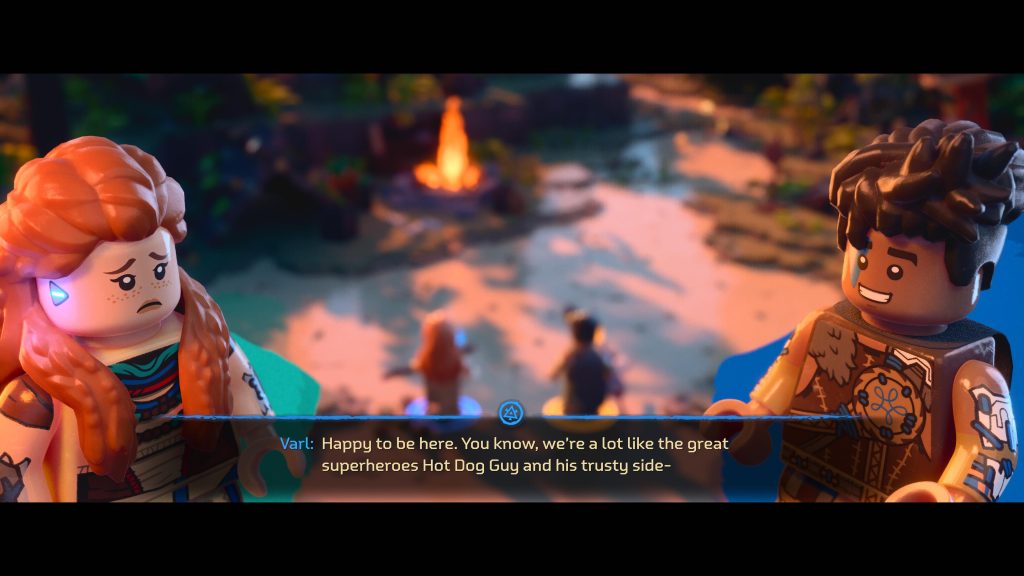
Aloy, Rost, Varl and Erend’s voice actors all return, though the now-playable Teersa sees a new voice take over, and each actor imbues their characters with so much energy that I felt like I was falling in love with them all over again. Aloy in particular feels like she has been injected with new life, thanks in part to Ashly Burch’s far more energetic performance compared to the seriousness she and the rest of the cast were asked to portray in the original. They maintain core aspects of their original characters, and are given far more leeway to have fun with the material they are given.
One issue some people I know have had with the original games was Aloy’s personality, but even they would surely become delighted by her peppy, eager nature that is a clear departure from the original material. Those previously frustrated with her extremely talkative nature upon Horizon Forbidden West’s launch will find themselves excited to hear the comedic banter she has with her group. Pretty much everyone is dumbed down in a way that works for younger audiences while providing old fans like me with fresh, new, funny ways to view fan favorites.
One small issue, but one that kept popping up, was the character’s dialogue switching to the next line a bit too quickly. It’s noticeable and distracting, and at times, can even ruin the delivery of one of the game’s many jokes.
Cooperative Chaos

Lego Horizon can be played alone, but a lot of the charm comes from experiencing the many surprising challenges of the wilds with a buddy. While I couldn’t try out the online multiplayer aspect, I was able to go through most of the 7-8 hour experience with a younger coop buddy eagerly accompanying me. Playing with another person is undoubtedly the best way to experience this game, as things get surprisingly difficult, so having someone act as both a decoy and support can keep you alive in the toughest of encounters.
You’re able to collect gadgets and rare weapons that serve as upgrades throughout each level, and are always in limited supply. My initial shock of there not being any dodge button, but only a jump button was replaced with understanding as some abilities could serve that very purpose. A dodge isn’t totally necessary in this game, as pretty much all the attacks are able to be evaded with the simple strategy of running away or jumping over it.
There is an upgrade station where you can permanently boost some things like the amount of experience gained by removing weakpoints, or even starting with random gadgets and weapons on each expedition. Thankfully, these apply to even your coop buddy, so they don’t have to worry about their own progress.
Leveling up specific characters allows access to some simple, but very necessary upgrades that you’re sure to need along the way. Going up to Level 20, you can increase your weapon damage, your base health, and increase some damage resistance among a few other things. There’s nothing revolutionary here, but it is always satisfying seeing your character level up in the middle of a mission and get healed.
You can’t change your character in the middle of a level, but this isn’t a bad thing, as it allows you to get accustomed to any one of the very capable playable characters. I found myself fond of Teersa and her chicken bombs, with the potential upgrades for her primary bomb being equal parts wildly effective and hilarious to see. Each character is equally viable, and it’s easy to find yourself switching between them every mission to see what unique abilities they offer.
Sadly, the randomized weapon and upgrade system can backfire, as there’s a few that are noticeably more useful than others. Getting to dodge with Rush Boots are okay, but given how easy it is to dodge enemy attacks, it feels useless compared to something like a Gravity Bomb that deals damage in an area. Sometimes, some weapons will trivialize entire sections and bosses, with Shock arrows being rather overpowered in Cauldrons, and Varl’s Boomerang Spear working great on larger enemies.
Lovely Lego Levels
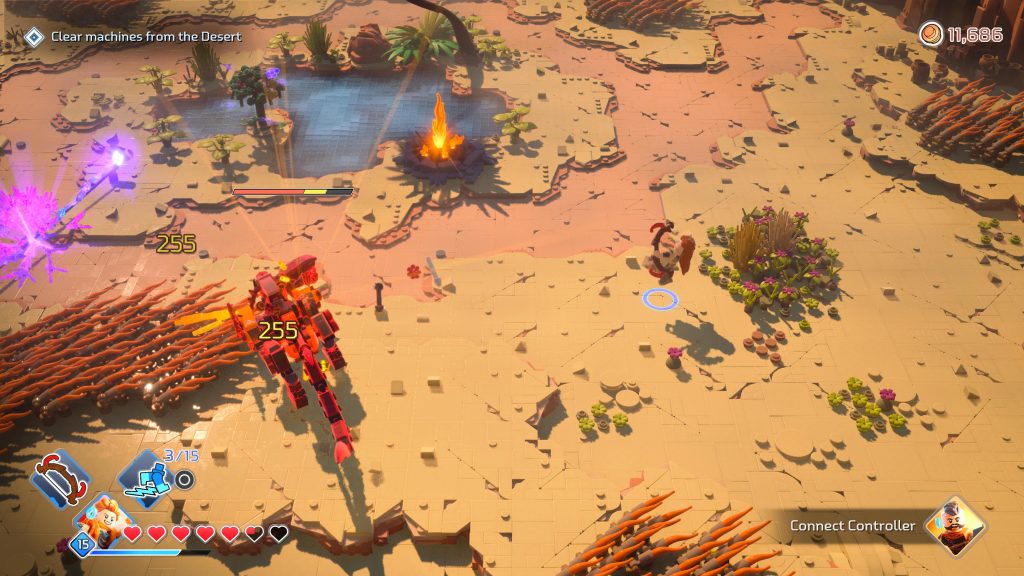
Going through the base story condensed down into a much shorter experience, you will still get to see the expected environments and landscapes you’ve already encountered in the original, but in a way that is incredibly rare to see. Every bit of the environment is made out of Lego pieces, and while everything may be bricks, they’re some of the most beautiful bricks I’ve ever seen.
The lighting and attention put into detail for every single level is astounding, making for what very well may be one of the most technically impressive Lego games. There is nothing to be found that breaks the immersion and idea that you are playing a pure Lego game, and I wouldn’t complain if I were to find a Lego set of one of these areas under my Christmas tree this year.
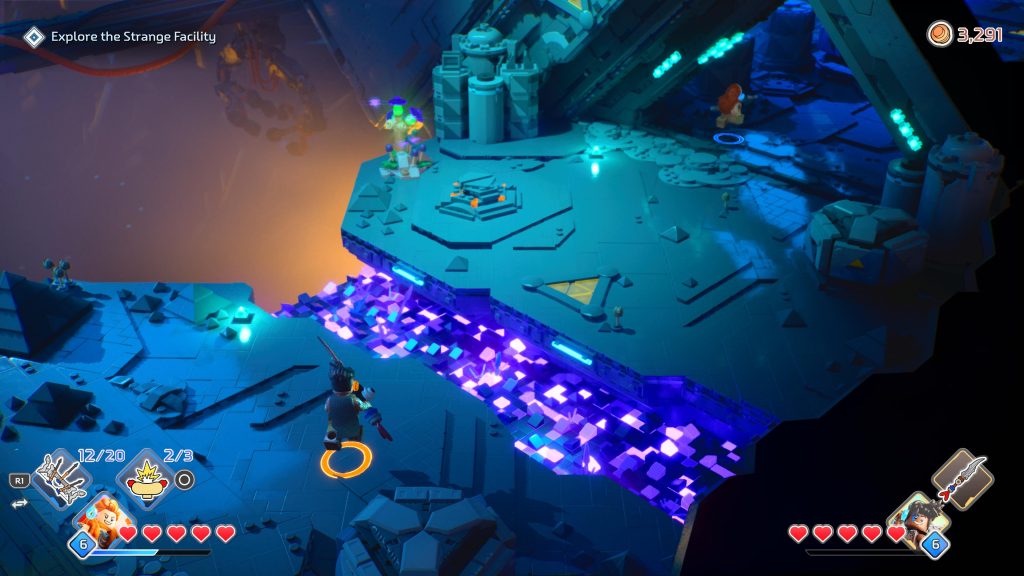
Though things do run the risk of becoming repetitive, and sometimes even do with the lack of new designs past linear traversal with minimal exploration, boss fights do keep popping up to make things somewhat interesting. There aren’t really that many puzzles blocking progression, with the only roadblocks being gates that need electricity to be opened, usually found in the form of barrels around the environment. It’s nothing too complicated, and their presence doesn’t add much to the experience.
While the outdoor environments are fantastic, just as great are the Cauldrons, where things take a far darker turn visually. The lighting in these areas are fantastic, with the usual purples keeping things bright despite the enclosed environments. The textures and lighting are especially noteworthy when there are close-ups of the characters, and the visual detail of each individual piece makes them all feel so authentic.
Exciting Expeditions
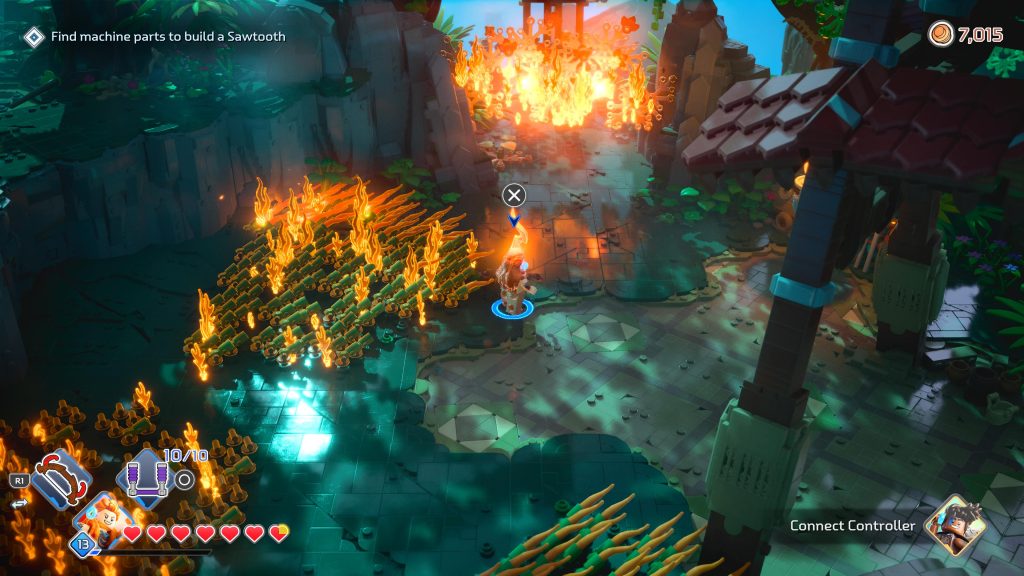
The gameplay revolves around maneuvering around opponents and striking at the right place at the right time, and it’s a very effective gameplay loop. Human enemies are very simple to deal with, and can be thrown around with a simple button press, and even deal a bit of damage if you throw them at another enemy.
Robot enemies are where the game focuses, and thankfully, shines. Much like the original, robots have weakspots that not only are able to deal more damage, but if you have the right upgrades, provide more experience points when successfully removed. Shooting at a Grazer normally will do damage, but it’s best to go behind them and strike their most vulnerable weakspot to deal the most damage.
The robots are varied enough and get mixed together enough that they don’t turn into mind-numbingly easy encounters. These robots, especially on higher difficulties, deal quite a lot of damage, and their attack patterns are always clear, telegraphed, and easy to dodge. You get used to a Watcher’s homing attack, but it gets more complicated when there’s about three other enemies gunning for you at the same time. It always does end up boiling down to striking a clear and obvious weakspot, so the only real difference between the robots are the attacks to dodge and health.
There is a stealth option, and with the right upgrades, hits from bushes can deal more damage. Unfortunately, it feels rather useless, especially when enemies are too far away for your weapon’s draw to even reach. Thankfully, there are environmental hazards like barrels of varying elemental effects that can be used to even the odds. The environment can be used well to eliminate or isolate enemies, and it’s satisfying aiming a shot over an elemental puddle and getting that extra boost of damage and utility.
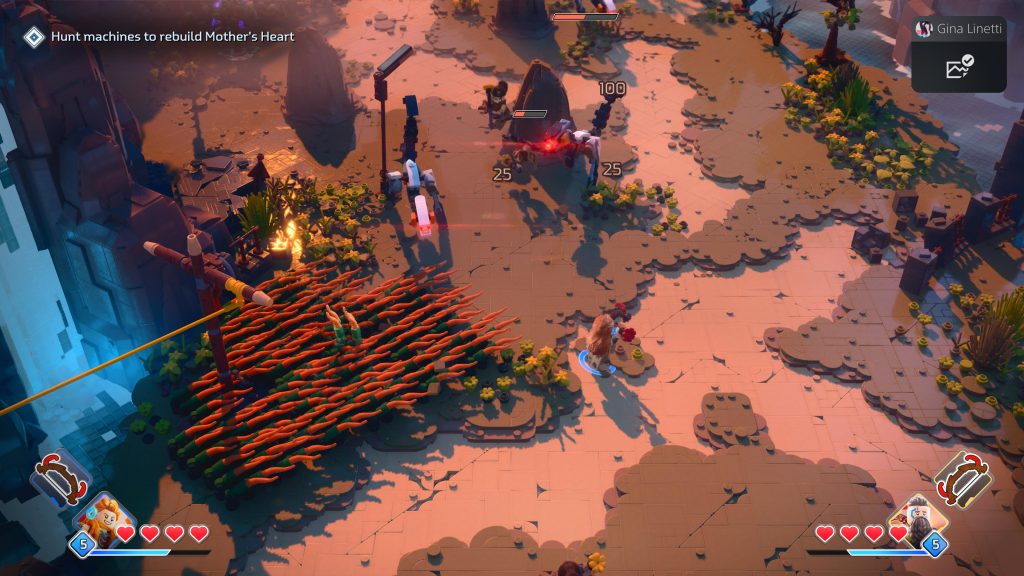
One problem with the mission structure is that you can’t go back and revisit specific moments in the story. I can’t quite return to an exciting Nora rescue, with that being replaced by a basic expedition that just rewards with studs. The only way to replay boss battles is through the Apex Machine Hunts, but once done, the only thing playable levels left are expeditions that are essentially just every level you played through, further highlighting the lack of variety throughout the game’s available areas.
After the main story and the Apex Machine Hunts, building and completing tasks from the community board are the only things really available left to do. Completing tasks can range from simple activities done in Mother’s Heart, to tasks like destroying 15 machines with barrels. They’re not the most complex, but they give additional rewards that are used to unlock new upgrades, so they’re best not totally ignored.
Sadly, some tasks’ ability to be completed can rely heavily on RNG. I couldn’t complete a mission for quite a while where I, dressed as a Ninjago character, had to defeat burning enemies simply because the game refused to drop anything that could inflict such a status on enemies. Oddly enough, one task where I had to complete a cauldron using a Blue Spacesuit did not let me receive the gold bricks it should give me, despite having done everything needed, including waiting for a cauldron to pop up in the randomly generated expeditions. This has occurred twice already and I don’t have hope for a third attempt.
Replayability after completion is rather limited, as there aren’t any collectibles or new levels to unlock after completing all of the Apex Machine Hunts. I finished every level the game offered and unlocked all the purchasable upgrades with my characters at an average of around level 16. That 7-8 hour completion time is made worse by the fact it took only somewhere between 11-12 to complete every single mission, so the $60 price point is more than a bit questionable for the lack of levels available after completing everything it has to offer.
We Built This Village!

One final piece of this puzzle is the hub area, Mother’s Heart, where you can create your own village based off of buildings from Horizon, Ninjago and a few more. Customizing what each area looks like is great, and the amount of options does give some incentive to keep playing to unlock new building options.
Even better is that a good number of these buildings can be interacted with. I had a good laugh watching the market stall I built be the popular dining destination of the residents of a chicken coop just across from them. Some interactions rewarding you with valuable gold bricks is a fantastic bonus to seeing your character interact with these intricately designed buildings.
In addition to Mother’s Heart, there are customization options available for all the playable characters. There are options available to customize the cast as one of the Lego Ninjago warriors, spacemen, or even food. It’s easy to get lost in making the goofiest possible outfit for one of the characters, and at the end of the day, Erend dressed as a pea pod is pretty charming.
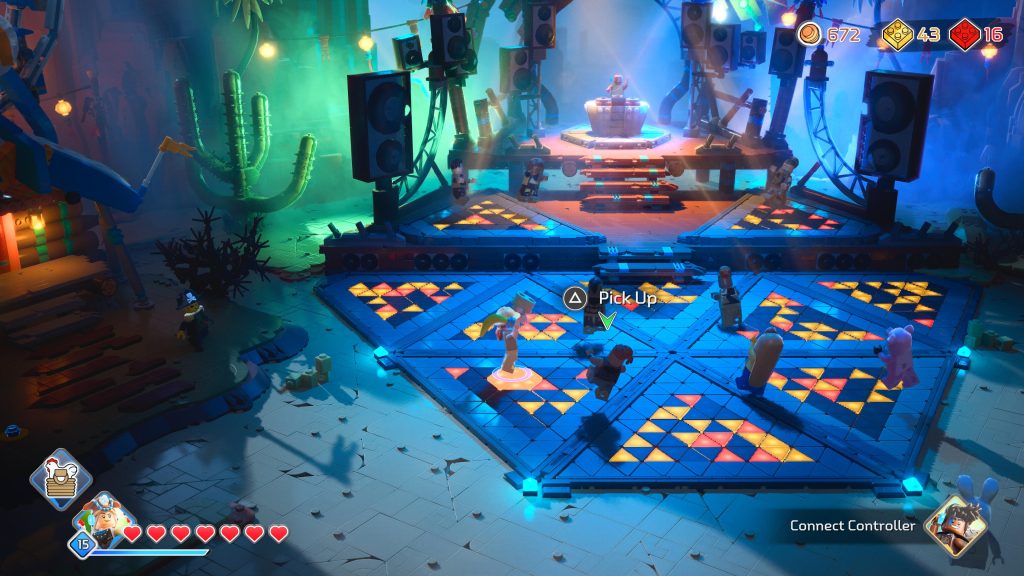
The music in the game is very fitting, being energetic and bright enough to match the family audience it’s targeting. Dance floors that can be built have music you can leave your character to dance to, though nothing here really does stand out. The audio design of the game does also help in landing the impact one can only imagine weapons would have on enemies.
There are some accessibility options also present, with 5 difficulty options to truly emphasize how wide the audience they’re trying to reach is. The options aren’t the most in-depth, but for a reason, as Lego Horizon is a very simple game. There are quality presets on the PS5 version of the game, with a performance and a fidelity mode, though I mainly stuck to the performance mode as the frame rate difference that fidelity has is too distracting.
Verdict

Lego Horizon Adventures is a solid point-of-entry into the series for younger audiences, and older fans of the series will be delighted to see a strong, very funny reinterpretation of the first game’s events. The combat is surprisingly involved, with some pretty fun combat encounters and some unfortunately overly simple stealth. The lack of either strong, or any variety and a proper mission replay option does drag it down a lot, with its short length and poor replayability especially calling the price point into question. Thankfully, the game is just fun enough recommend, albeit ideally at a lower price point than the one it is currently at.








